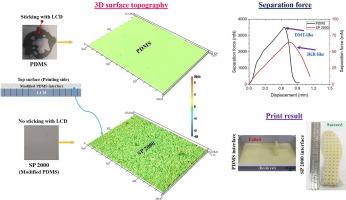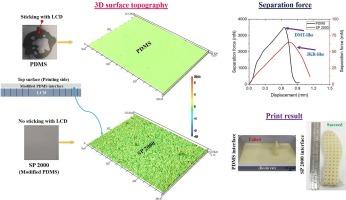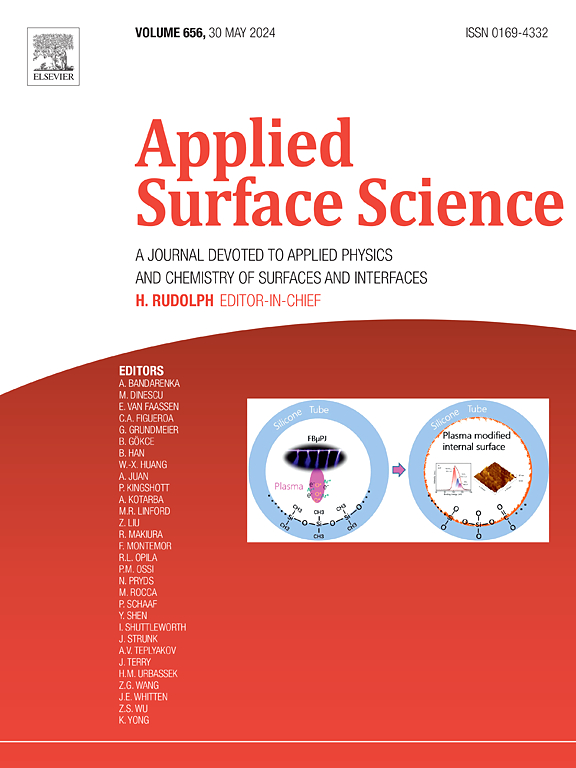Nanoscale roughness to mitigate polydimethylsiloxane (PDMS) sticking in liquid crystal display (LCD) vat photopolymerization (VPP): Separation force reduction without losing resolution
IF 6.3
2区 材料科学
Q2 CHEMISTRY, PHYSICAL
引用次数: 0
Abstract
Liquid crystal display (LCD) vat photopolymerization (VPP) is gaining attention among polymer-based additive manufacturing (AM) processes due to its high accuracy, superior surface finish, and cost-efficiency. However, one of the main challenges is the high layer separation force, which is heavily influenced by the flexibility of the interface. Sticking between polydimethylsiloxane (PDMS) and the LCD panel reduces flexibility, shifting the separation behavior from Johnson-Kendall-Roberts (JKR) to Derjaguin-Muller-Toporov (DMT)-like behavior. This study presents a novel approach to mitigate PDMS sticking by introducing nanoscale surface roughness. Sandblasted sheet metals with varying sand mesh sizes were used as molds to create interfaces with different roughness levels. The findings reveal that a surface roughness of 0.262µm significantly reduces PDMS sticking, making the interface more flexible. The optimized flexible interface (SP 2000) interface reduced the separation force 50-fold compared to unmodified PDMS while maintaining high print resolution. Case studies involving rigid and flexible photopolymer resins further emphasize the effectiveness of the SP 2000 interface in addressing PDMS sticking issues. This research highlights the critical role of interface flexibility and presents a promising solution for improving LCD VPP performance.


纳米级粗糙度可减轻液晶显示器 (LCD) 大桶光聚合 (VPP) 中的聚二甲基硅氧烷 (PDMS) 粘连:降低分离力,同时不损失分辨率
液晶显示器(LCD)大桶光聚合(VPP)因其高精度、出色的表面光洁度和成本效益,在聚合物基增材制造(AM)工艺中日益受到关注。然而,主要挑战之一是层分离力大,这在很大程度上受到界面柔韧性的影响。聚二甲基硅氧烷(PDMS)和液晶面板之间的粘连会降低柔韧性,使分离行为从约翰逊-肯德尔-罗伯茨(JKR)转变为类似于德雅金-穆勒-托波洛夫(DMT)的行为。本研究提出了一种通过引入纳米级表面粗糙度来减轻 PDMS 粘连的新方法。使用不同砂目尺寸的喷砂金属板作为模具,创建具有不同粗糙度的界面。研究结果表明,0.262 µm 的表面粗糙度可显著减少 PDMS 粘附,使界面更具柔韧性。与未经改性的 PDMS 相比,优化的柔性界面 (SP 2000) 接口在保持高打印分辨率的同时,将分离力降低了 50 倍。涉及刚性和柔性光聚合物树脂的案例研究进一步强调了 SP 2000 接口在解决 PDMS 粘连问题方面的有效性。这项研究强调了界面柔性的关键作用,并为提高液晶显示屏的 VPP 性能提供了一种前景广阔的解决方案。
本文章由计算机程序翻译,如有差异,请以英文原文为准。
求助全文
约1分钟内获得全文
求助全文
来源期刊

Applied Surface Science
工程技术-材料科学:膜
CiteScore
12.50
自引率
7.50%
发文量
3393
审稿时长
67 days
期刊介绍:
Applied Surface Science covers topics contributing to a better understanding of surfaces, interfaces, nanostructures and their applications. The journal is concerned with scientific research on the atomic and molecular level of material properties determined with specific surface analytical techniques and/or computational methods, as well as the processing of such structures.
 求助内容:
求助内容: 应助结果提醒方式:
应助结果提醒方式:


